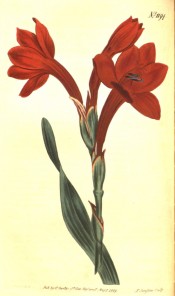Watsonia meriana (L.) Mill.
Cormous perennial with sword-shaped leaves and branched spikes of up to 25 tubular, bright red, occasionally scarlet or white, flowers in summer. To 2m. Sometimes produces cormels at the leaf nodes. [RHSE, CECB, Hortus].
Horticultural & Botanical History
‘Mr. Miller informs us in his Dictionary, that he raised this most elegant species of Antholyza from seeds sent him by his friend Dr. Job Baster, which succeeded in the Chelsea garden in 1756; conceiving it to be a distinct genus, he named it Watsonia, in honour of Mr. (afterwards) Sir William Watson. […] It is a much stronger plant than the Antholyza cunonia [Gladiolus cunonius], and that though the colour of its flowers is not so splendid, the whole plant possesses more elegance.’ [BM t.418/1798]. Improved varieties seem to have soon become available: ‘This splendid variety of Meriana [‘Largest Merian’s Watsonia, or Scarlet Tuberose’] was imported some years ago, by Mr. Wykes, from Holland. The species is native of the Cape; but this variety has most probably obtained by the industry of the Dutch growers.’ [BM t. 1194/1809].
History at Camden Park
Listed in all published catalogues [B.447/1843].
Notes
Published Nov 18, 2009 - 05:25 PM | Last updated Jul 25, 2010 - 03:17 PM
| Family | Iridaceae |
|---|---|
| Category | |
| Region of origin | South Africa, Cape district |
| Synonyms |
|
| Common Name | Bugle lily |
| Name in the Camden Park Record | Watsonia meriana |
| Confidence level | high |
